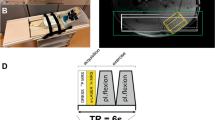Abstract
To investigate the splitting of the inorganic phosphate (Pi) peak during exercise and recovery, a time-resolved 31phosphorus nuclear magnetic resonance spectroscopy (31P-MRS) technique was used. Seven healthy young sedentary male subjects performed knee flexion exercise in the prone position inside a 2.1-T magnet, with the surface coil for 31P-MRS being placed on the biceps femoris muscle. After a 1-min warm-up without loading, the exercise intensity was increased by 0.41 W at 15-s intervals until exhaustion, followed by a 5-min recovery period. The 31P-MRS were recorded every 5 s during the rest-exercise-recovery sequence. Computer-aided contour analysis and pixel imaging of the Pi and phosphocreatine peaks were performed. Five of the seven subjects showed two distinct Pi peaks during exercise, suggesting two different pH distributions in exercising muscle (high pH and low pH region). In these five subjects, the high-pH increased rapidly just after the onset of exercise, while the low-pH peak increased gradually approximately 60 s after the onset of exercise. During recovery, the disappearance of the high-pH peak was more rapid than that of the low-pH peak. These findings suggest that our method 31P-MRS provides a simple approach for studying the kinetics of the Pi peak and intramuscular pH during exercise and recovery.
Similar content being viewed by others
References
Achten E, Van Cauteren M, Willem R, Luypaert R, Malaisse WJ, Van Bosch G, Delanghe G, De Meirleir K, Osteaux M (1990) 31P-NMR spectroscopy and the metabolic properties of different muscle fibers. J Appl Physiol 68:644–649
Binzoni T, Ferretti G, Senker K, Cerretelli P (1992) Phosphocreatine hydrolysis by 31P-NMR at the onset of constant-load exercise in humans. J Appl Physiol 73:1644–1649
Gardian DG, Radda GK, Dawson MJ, Wilkie DR (1982) pH measurements of cardiac and skeletal muscle using 31P-NMR. In: Nuccitelli R, Deamer DW (eds) Intramuscular pH: its measurement, regulation and utilization in cellular functions. Liss, New York, pp 61–77
Gollnick PD, Armstrong RB, Saltin B, Saubert CW IV, Sembrowich WL, Shephard RE (1973a) Effect of Training on enzyme activity and fiber composition of human skeletal muscle. J Appl Physiol 34:107–111
Gollnick PD, Armstrong RB, Sembrowich WL, Shephard RE, Saltin B (1973b) Glycogen depletion pattern in human muscle fibers after heavy exercise. J Appl Physiol 34:615–618
Gollnick PD, Karlsson J, Piehl K, Saltin B (1974a) Selective glycogen depletion in skeletal muscle fibers of man following sustained contractions. J Physiol 241:59–67
Gollnick PD, Piehl K, Saltin B (1974b) Selective glycogen depletion pattern in human muscle fibers after exercise of varying intensity and varying pedalling rates. J Physiol 241:45–47
Hochachka PW, Matheson GO (1992) Regulating ATP turnover rates over broad dynamic work ranges in skeletal muscles. J Appl Physiol 73:1697–1703
Jeneson JAL, Wesseling MW, De Boer RW, Amelink HG (1989) Peak-splitting of inorganic phosphate during exercise: anatomy or physiology? A MRI-guided 31PMRS study of human forearm muscle. In: Proceedings of the Eighth Annual Meeting of the Society of Magnetic Resonance in Medicine. Abstract no. 1030. Society of Magnetic Resonance in Medicine, Berkeley, Calif.
Kushmerick MJ, Meyer RA (1985) Chemical changes in rat leg muscle by phosphorus nuclear magnetic resonance. Am J Physiol 248:C542-C549
Marsh GD, Paterson DH, Thompson RT, Driedger AA (1991) Coincident thresholds in intracellular phosphorylation potential and pH during progressive exercise. J Appl Physiol 71:1076–1081
Meyer RA (1988) A linear model of muscle respiration explains monoexponential phosphocreatine changes. Am J Physiol 254:C548-C553
Meyer RA, Brown TR, Kushmerick MJ (1985) Phosphorus nuclear magnetic resonance of fast- and slow-twitch muscle. Am J Physiol 248:C279-C287
Miller RG, Boska MD, Moussavi RS, Carson PJ, Weiner MW (1988) 31P nuclear magnetic resonance studies of high energy phosphates and pH in human muscle fatigue. J Clin Invest 81:1190–1196
Mizuno M, Justesen LO, Bedolla J, Riedman DB, Secher NH, Quistroff B (1990) Partial curarization abolishes splitting of the inorganic phosphate peak in 31P-NMR spectroscopy during intense forearm exercise in man. Acta Physiol Scand 139:611–612
Mizuno M, Secher NH, Quistroff B (1994a) 31P-NMR spectroscopy, rsEMG, and histochemical fiber types of human wrist flexor muscles. J Appl Physiol 76:531–538
Mizuno M, Horn A, Secher NH, Quistroff B (1994b) The exercise-induced 31P-NMR metabolic response of human wrist flexor muscles during partial neuromuscular blockade. Am J Physiol, in press
Mole PA, Coulson RL, Caton JR, Nichols BG, Barstow TJ (1985) In vivo 31P-NMR in human muscle: transient patterns with exercise. J Appl Physiol 59:101–104
Park JH, Brown RL, Park CR, McCully KK, Cohn M, Hasellgrove J, Chance B (1987) Functional pools of oxidative and glycolytic fibers in human muscle observed by 31P-magnetic resonance spectroscopy during exercise. Proc Natl Acad Sci USA 84:8976–8980
Taylor DJ, Bore PJ, Styles P, Gardian DG, Radda GK (1983) Bioenergetics of intact human muscle. A 31P nuclear magnetic resonance study. Mol Biol Med 1:77–94
Vandenborne K, MuCully K, Kakihara H, Prammer M, Bolinger L, Detre JA, De Meirleie K, Walter G, Chance B, Leigh JS (1991) Metabolic heterogeneity in human calf muscle during maximal exercise. Proc Natl Acad Sci USA 88:5714–5718
Yoshida T, Watari H (1992a) Noninvasive and continuous determination of energy metabolism during muscular contraction and recovery. Med Sport Sci 37:364–373
Yoshida T, Watari H (1992b) Muscle metabolism during repeated exercise studied by 31P-MRS. Ann Physiol Anthrop 37:364–373
Yoshida T, Watari H (1993a) 31P-Nuclear magnetic resonance spectroscopy study of the time course of energy metabolism during exercise and recovery. Eur J Appl Physiol 66:494–499
Yoshida T, Watari H (1993b) Metabolic consequences of repeated exercise in long distance runners. Eur J Appl Physiol 67:261–265
Yoshida T, Watari H (1993c) Changes in intracellular pH during repeated exercise. Eur J Appl Physiol 67:274–278
Author information
Authors and Affiliations
Rights and permissions
About this article
Cite this article
Yoshida, T., Watari, H. Exercise-induced splitting of the inorganic phosphate peak: investigation by time-resolved 31P-nuclear magnetic resonance spectroscopy. Eur J Appl Physiol 69, 465–473 (1994). https://doi.org/10.1007/BF00239861
Accepted:
Issue Date:
DOI: https://doi.org/10.1007/BF00239861




